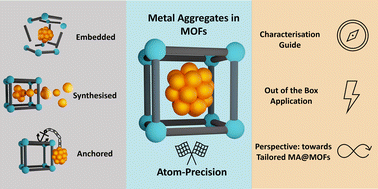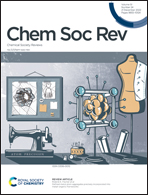Defined metal atom aggregates precisely incorporated into metal–organic frameworks
Abstract
Nanosized metal aggregates (MAs), including metal nanoparticles (NPs) and nanoclusters (NCs), are often the active species in numerous applications. In order to maintain the active form of MAs in “use”, they need to be anchored and stabilised, preventing agglomeration. In this context, metal–organic frameworks (MOFs), which exhibit a unique combination of properties, are of particular interest as a tunable and porous matrix to host MAs. A high degree of control in the synthesis towards atom-efficient and application-oriented MA@MOF composites is required to derive specific structure–property relationships and in turn to enable design of functions on the molecular level. Due to the versatility of MA@MOF (derived) materials, their applications are not limited to the obvious field of catalysis, but increasingly include ‘out of the box’ applications, for example medical diagnostics and theranostics, as well as specialised (bio-)sensoring techniques. This review focuses on recent advances in the controlled synthesis of MA@MOF materials en route to atom-precise MAs. The main synthetic strategies, namely ‘ship-in-bottle’, ‘bottle-around-ship’, and approaches to achieve novel hierarchical MA@MOF structures are highlighted and discussed while identifying their potential as well as their limitations. Hereby, an overview of standard characterisation methods that enable a systematic analysis procedure and state-of-art techniques that localise MA within MOF cavities are provided. While the perspectives of MA@MOF materials in general have been reviewed various times in the recent past, few atom-precise MAs inside MOFs have been reported so far, opening opportunities for future investigation.



 Please wait while we load your content...
Please wait while we load your content...